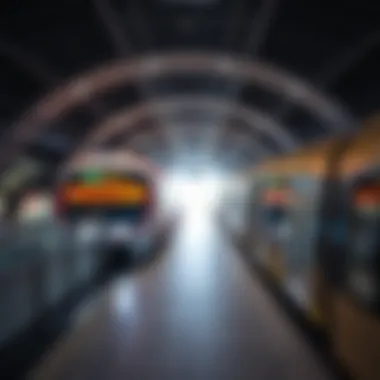Metro Travel Between Abu Dhabi and Dubai: A Comprehensive Guide


Intro
The transportation landscape of the United Arab Emirates is evolving, and one of the most significant developments has been the metro system linking Abu Dhabi and Dubai. This ambitious project not only enhances the connectivity between two major metropolitan areas but also paves the way for economic growth and urban expansion. As cities grow, so does the necessity for efficient transit options. Understanding the operational details of this metro system, like ticket pricing and travel durations, is vital for anyone looking to traverse these bustling urban centers.
But the metro is not just a means of getting from point A to point B. It’s intertwined with the broader narrative of real estate and urban development in the UAE. Investors and property managers have an especially keen eye on how such transportation initiatives can influence market dynamics and neighborhood desirability. With the right insights, the potential for smart investment can be unlocked, allowing investors to make well-informed decisions.
In this article, we will explore the intricacies of the metro system, touching on its design, functionality, and relevance to market trends. By delving deeper, investors will not only grasp the efficiency of the transit system but also understand its implications for urban growth and real estate investment opportunities.
Preamble to Metro Connectivity
The interconnection between Abu Dhabi and Dubai through metro transport is more than just a matter of convenience; it is a significant stride toward modernizing urban mobility in the UAE. This metro system not only acts as a vital link between two prominent cities but also underscores the importance of efficient transport in fostering economic growth and enhancing everyday life for residents and visitors alike.
The Importance of Efficient Transport
In bustling metropolises like Abu Dhabi and Dubai, effective transportation is the lifeblood of daily operations. The reliance on personal vehicles often leads to congested roads and increased emissions. Thus, an efficient metro system emerges as a practical solution to alleviate these issues. A swift and reliable transportation infrastructure connects people not just to their work, but to leisure, healthcare, and education, making it a cornerstone for community development.
Efficient transport systems can lead to:
- Economic Growth: By reducing commute times, businesses can enhance productivity.
- Reduced Traffic Congestion: Substituting car travel with metro transit decreases the number of vehicles on the roads.
- Lower Environmental Impact: With the rise of electric and renewable energy-powered metro systems, the overall carbon footprint can be significantly reduced.
Moreover, for investors, understanding the transport dynamics is crucial. Areas adjacent to metro stations often see an uptick in property values and rental demand. This makes the metro connectivity not just a matter of convenience but a lucrative focal point for real estate decisions.
Abu Dhabi and Dubai: A Geographic Overview
Geographically, Abu Dhabi and Dubai are positioned close to each other; however, the urban landscapes and cultures vary significantly. Abu Dhabi, the capital of the UAE, is a city defined by its rich history and vast expanses. It’s home to governmental institutions, cultural landmarks, and quieter residential neighborhoods. In contrast, Dubai is well-known for its vibrant lifestyle, towering skyscrapers, and tourist attractions, making it a hub of commerce and tourism.
- Abu Dhabi:
- Dubai:
- Capital city, political center
- Characterized by wide roads and modern architecture
- Emphasis on sustainability and urban development
- Vibrant, multi-cultural metropolis
- Renowned for its shopping, nightlife, and entertainment
- High population density and dynamic real estate market
The geographical ties between these cities facilitate daily commuting for countless residents who work or study across from each city. The metro system becomes a bridge that not only simplifies travel but also connects diverse cultures and lifestyles.
"An efficient metro system is not just about speed; it’s about transforming lives and enhancing regional connectivity."
Overall, the narrative of metro connectivity between Abu Dhabi and Dubai is a crucial element to understand as it serves both practical needs and broader socio-economic goals. Investors, urban planners, and property managers must recognize the implications this connectivity holds for real estate and urban development.
The Metro System Explained
The metro system is not just a network of trains zipping between Abu Dhabi and Dubai; it serves as the veins of modern connectivity in the UAE. The sheer scale and sophistication of this operation underscore the region's commitment to sustainable urban growth and mobility. Understanding this system is crucial, not just for daily commuters but also for investors and stakeholders who keep their eyes peeled for emerging trends in the urban landscape.
Understanding the Infrastructure
The metro is built on a foundation of precision engineering and cutting-edge technology. The infrastructure comprises several key components that work seamlessly together:


- Tracks: These are meticulously laid down, ensuring the smooth transit of trains at optimal speeds. The alignment of the tracks connects major urban centers while minimizing travel time.
- Stations: Each station is designed not merely as a stop but as a hub of activity. They provide access to various amenities, including shops, cafes, and even co-working spaces. The design reflects the culture and identity of the surrounding area, making them points of interest in themselves.
- Control Systems: Modern signal management and real-time tracking ensure safety and efficiency. Advanced systems facilitate passenger information, helping travelers navigate their journey well.
- Maintenance Facilities: Maintenance is crucial for long-term reliability. The metro's infrastructure includes specialized facilities dedicated to the upkeep of trains and tracks, ensuring high service levels year-round.
This intricate web of infrastructure supports not just transportation but envisages a broader lifestyle shift, where urban sprawl meets efficiency.
Types of Metro Services Available
When it comes to services, the metro offers various options tailored to different needs:
- Express Services: These are geared toward business professionals who need to make quick trips between the cities. Generally fewer stops mean your travel time can be cut considerably — a boon for tight schedules.
- Local Services: Ideal for everyday commuters, these services connect neighborhoods that may not otherwise have easy access to the metro. Passengers traveling within cities often benefit from the extensive network these services provide.
- Tourist Services: Special routes cater to tourists, connecting major attractions and landmarks. This allows visitors to experience the cities without the hassle of navigating through traffic.
- Special Services: During events or peak seasons, additional trains can be put in service to accommodate larger crowds. This flexibility ensures that the metro continues to meet the demands of a growing population.
"The metro system is an investment in the future of UAE's urban landscape. It's not just about getting from point A to point B but about integrating communities and boosting economic growth."
Traveling from Abu Dhabi to Dubai
Traveling between Abu Dhabi and Dubai has always been a topic of interest, especially for those living, working, or investing in the UAE. With a distance of about 150 kilometers, the two emirates are often at the intersection of various economic, social, and cultural exchanges. The metro system that connects these cities is not just a convenience; it embodies the growth and modernization of urban life in the region. The importance of this route stretches beyond the daily commutes, influencing patterns in real estate, tourism, and even local culture.
Key Stations Along the Route
When you hop onto the metro, there are several key stations that stand out along the route from Abu Dhabi to Dubai. Each station acts as a microcosm of the emirates' vibrant life, serving not just as stops but as gateways to broader experiences.
- Abu Dhabi Central Station: The journey kicks off here, showcasing modern architecture and easy access to various local amenities. This area serves as the heart of Abu Dhabi's transport network, linking travelers efficiently.
- Al Ain Market Station: A unique stop that provides a glimpse of traditional Emirati culture juxtaposed with modernity. This stop offers access to a bustling market and local food joints, making it a favored pit stop for commuters looking for a taste of the local fare.
- Sheikh Zayed Road Station: Known for its impressive skyscrapers and business hubs, this area is a nod to the rapid development Dubai has undergone. It is near major attractions such as the Burj Khalifa and the Dubai Mall, solidifying its importance for both tourists and business travelers.
- Dubai International Airport Station: This major transit hub connects travelers arriving from around the globe directly to the metro system. As a crucial point for international travelers, it enhances accessibility and convenience, catering to the increasing volume of visitors.
Each of these stations serves a distinct purpose, tailoring to the needs of various travelers, whether they are heading to work, exploring new opportunities, or indulging in leisure activities.
Estimated Travel Time
One of the prime advantages of the metro system is its efficiency. The estimated travel time from Abu Dhabi to Dubai, unsurprisingly, varies based on a few variables such as waiting times and travel conditions. However, a direct journey generally spans about 60 to 75 minutes, offering a quick alternative to road travel.
Beyond the travel time itself, the comfort and predictability of the metro make it an appealing option for daily commuters. Travelers can enjoy the reliability of the metro service, which is less susceptible to the traffic jams that often plague the roads, especially during peak hours.
Frequency of Service
Understanding the frequency of service can significantly impact a traveler's experience. The metro provides substantial coverage with its timetable tailored to both peak and off-peak hours. Generally, trains run every 10 to 15 minutes during the day, and while the frequency may drop in the late hours, the service remains consistent.
For the business-minded traveler, this consistent frequency minimizes wait times and maximizes productivity. Moreover, planning around these schedules can be advantageous, especially for those with tight itineraries.
In summary, the metro journey from Abu Dhabi to Dubai encapsulates the essence of connectivity that fosters growth in multiple sectors. Whether you're eyeing real estate opportunities or merely commuting to work, understanding the operational nuances can vastly enhance your experience. Travelers are encouraged to make the most of this evolving transport system, designed to meet the dynamic needs of a modern society.
Ticketing and Pricing
In this bustling age where connectivity makes the world more accessible, understanding the ins and outs of ticketing and pricing in the Abu Dhabi-Dubai metro system is absolutely vital. Not only does it streamline the travel experience, but it also influences how potential investors might perceive the value of properties near metro stations. A well-structured pricing model encourages frequent use, which in turn boosts foot traffic and business opportunities around the stations.
Understanding Fares
One of the first things to grasp when navigating the metro is the fare structure. The costs are based on a zone system, which can be a bit perplexing for newcomers. As of now, a single journey between Abu Dhabi and Dubai typically ranges from about 8 to 20 dirhams, depending on the zones crossed. It’s best to familiarize oneself with these zones before boarding since overshooting your fare results in extra charges!
"Knowing your fare zones can save you from unexpected costs!"


It’s worth noting that having a prepaid card, like the NOL Card or Hafilat Card, can make the transaction smoother and possibly provide slight discounts. Regular commuters might find that investing in monthly passes also leads to significant savings over time, especially for those in the real estate sector whose work mandates frequent travel between these two vibrant cities.
Types of Ticket Options
When it comes to choosing how to pay for your metro journey, the options are more varied than one might think. Here’s a breakdown:
- Single Journey Ticket: Perfect for occasional travelers. Valid for just one trip between two stations, it may become a less economical choice for routine trips.
- Day Pass: For those needing unlimited travel in a single day, this option allows you to hop between stations at a fixed price. It’s fantastic for business meetings or property showings across town.
- Monthly Pass: Tailored for regular commuters, this pass covers all journeys within a month in selected zones. It's a great move for property managers or agents who can’t afford any hiccups in their travel.
The flexibility in ticket options is designed to cater to varied travel needs, whether for business or pleasure, all while promoting ease of movement across the emirates.
Payment Methods and Platforms
As one would expect in a tech-savvy region, there are numerous ways to pay for metro tickets. Here are some prevalent methods:
- NOL Card: This smart card is a game-changer. It can be charged online or at stations and can be used across multiple forms of transportation in Dubai and surroundings.
- Mobile Apps: Various apps are available that allow users to purchase tickets on the fly. One such app, Dubai Metro, helps travelers to check fares, schedules, and even plan routes.
- Cash and Credit Payment at Stations: For those who prefer the old-school way, ticket machines accept both cash and cards. However, this may be less expedient during rush hours when queues can get long.
Having a variety of payment platforms illustrates the commitment to making travel seamless and accommodating for everyone, especially for those who are navigating the dynamic property landscape of the UAE.
In summary, keeping a keen eye on ticketing and pricing not only facilitates hassle-free travel but highlights the importance of metro connectivity in the rapid urban development of both Abu Dhabi and Dubai.
Convenience Factors for Travelers
Navigating from Abu Dhabi to Dubai via metro offers plenty of advantages that make it a convenient choice for many commuters. The swift connection between these two bustling cities not only enhances day-to-day mobility but also allows for better integration of urban life. These convenience factors are essential to understanding how users engage with the metro system and how it fits into their travel routines, especially for businesspeople and property investors.
Accessibility Features
Metro systems are designed to be user-friendly, and this is no different for the route linking Abu Dhabi and Dubai. Accessibility features are paramount in ensuring that everyone, regardless of mobility, can use the metro efficiently. Key elements include:
- Wheelchair Accessibility: Stations have dedicated ramps and lifts, allowing those in wheelchairs to navigate with ease.
- Designated Seating: Trains include spaces specifically reserved for individuals with disabilities, ensuring comfort and priority.
- Visual and Auditory Aids: Clear signage, announcements, and digital displays support those needing assistance in navigating the stations and platforms.
These features not only reflect a commitment to inclusive transport solutions but also enhance the daily commute for all passengers, making it more manageable to travel between cities.
Safety and Security Measures
When it comes to public transport, safety is often at the forefront of passengers’ minds. The metro connecting Abu Dhabi and Dubai places a significant emphasis on security to foster a safe travel environment. Important aspects include:
- Surveillance Systems: High-definition cameras monitor stations and trains to ensure passenger safety at all times.
- Onboard Security Personnel: Trained staff patrol the trains and platforms, ready to respond to any exigencies that could compromise safety.
- Emergency Protocols: Clearly displayed protocols detail procedures to follow in various scenarios, ensuring that passengers know how to act if the need arises.
"The security measures implemented not only safeguard commuters but also foster a sense of community trust in the metro system as a whole."
For further information on metro accessibility features and safety, please refer to Wikipedia and other related resources.
Impact on Real Estate Development
The metro system linking Abu Dhabi and Dubai has transformed the landscape of real estate across the UAE in many profound ways. As investors, agents, and property managers seek to understand how infrastructure influences property dynamics, the integration of metro connectivity stands out as a critical factor. This section explores the significant changes in property values and shifts in urban planning that occur with enhanced transportation links.
Increased Property Values


When a new metro line is introduced, the immediate effect often showcases an uptick in property values. This phenomenon can be attributed to several reasons. First, accessibility is a major player; properties situated near metro stations are more desirable as they offer a convenient commute. Residents are willing to pay a premium for ease of travel, making these locations particularly attractive for homebuyers and tenants alike.
Moreover, the prospect of daily convenience often converts into a solid investment. Many buyers see properties near metro services as a safer bet. For instance, areas like Al Rigga in Dubai, which boasted proximity to the metro, saw property prices soar after the service was introduced. Buyers are more inclined to invest based on future growth prospects, which are enhanced by proper connectivity.
"Access to public transport can make or break a property’s allure!"
Another aspect worth considering is the income potential of properties near metro stations. Investors can often command higher rents for properties that offer quick access to major urban hubs, enhancing yield opportunities. In regions like Abu Dhabi’s Al Reem Island, we see how the metro has not only kept property prices strong but has also attracted a host of new developments aimed at capitalizing on this demand.
Shift in Urban Planning Strategies
The advent of the metro system also prompts a notable shift in urban planning strategies. As local governments leverage improved transportation networks, we are witnessing a trend towards more sustainable and efficient urban designs. The integration of public transport into city planning leads to mixed-use developments—spaces where residential, commercial, and recreational facilities coexist harmoniously. This synergy reduces the need for cars, fostering a sense of community while also conceivably lessening traffic congestion.
Developers are now more inclined to focus on properties that support transit-oriented development, aligning with broader urban strategies. In Dubai, areas like Business Bay have seen a significant increase in investments geared toward enhancing both residential and commercial offerings, establishing a mini-ecosystem built around the metro.
Thus, it is clear that with the advent of metro connectivity, both property values and urban planning strategies adapt, creating a more dynamic and interconnected living environment.
Future Expansion Plans
The future of the metro system connecting Abu Dhabi and Dubai holds significant promise, not just for immediate transportation needs but also for long-term urban planning and development. This section elaborates on how expansion plans are crucial for enhancing operational efficiency, improving access, and addressing the growing demands of a rapidly urbanizing region. The intricate relation between public transportation and real estate dynamics cannot be overstated, as each expansion phase undoubtedly influences property values and city layouts.
Anticipated Developments in the Network
Given the increasing population and economic activity, it’s vital for the metro system to adapt and grow accordingly. Planned expansions include the extension of existing lines and the introduction of new routes that will further integrate peripheral areas into the central urban fabric. Some of the anticipated developments involve:
- New Lines and Stations: Route extensions towards the northern emirates and additional stations to ease the commuting burden.
- Increased Capacity: Upgraded trains and platforms designed to accommodate a higher volume of passengers, facilitating a smoother travel experience.
- Interconnectivity with Other Transport Modes: Establishing more seamless transfers between metro lines, buses, and taxis to provide comprehensive mobility solutions.
These developments are invaluable as they’ll likely stimulate economic growth and encourage investments in previously underserved areas. An enhanced metro network will not only draw more foot traffic to new commercial hubs but will also provide residents a better quality of life through improved accessibility.
Environmental Considerations in Expansion
While expansion is necessary, it is crucial to strike a balance between development and sustainability. With growing awareness about climate issues, future expansion plans must consider their environmental footprint. Here are some key aspects:
- Sustainable Materials: Employing eco-friendly construction materials and practices to minimize negative impacts on the environment during the building phase.
- Energy-Efficient Systems: Incorporating renewable energy sources into metro operations, such as solar panels on stations and at maintenance depots. This can significantly reduce the carbon footprint of transportation.
- Green Spaces: Planning new stations and routes to include green areas, which not only enhance aesthetics but also contribute to local biodiversity.
- Public Awareness Initiatives: Creating channels for community engagement to educate residents about the benefits of public transportation, potentially influencing behavioral shifts towards more sustainable commuting methods.
By prioritizing these considerations, future expansions can achieve not only functional and economic benefits but also foster a commitment towards building a sustainable and resilient urban community. As the metro grows, so too does its role as a backbone for future urban development and environmental stewardship.
Epilogue
In wrapping up our exploration of the metro system linking Abu Dhabi and Dubai, it's critical to grasp the layers of connectivity and its far-reaching implications. The metro not only serves as a mere transit solution; it embodies a blend of urban evolution and effective transport strategy. For investors and property managers, the advent of such infrastructure opens doors to lucrative opportunities in real estate, especially in areas surrounding metro stations that witness an uptick in demand.
Summing Up the Importance of Metro Connectivity
Metro connectivity stands as a cornerstone for sustainable urban growth, bringing forth a range of benefits that resonate with businesses and communities alike. Here are a few key points to consider:
- Enhanced Accessibility: The metro provides ease of access not just between Abu Dhabi and Dubai but also to various neighborhoods within each city. This interconnectedness facilitates smoother commutes for professionals and tourists, thereby boosting local economies.
- Environmental Impact: By promoting public transport usage, the metro helps to reduce traffic congestion and lower carbon emissions. It directly correlates with environmental sustainability, a factor increasingly prioritized by modern investors and urban planners alike.
- Economic Growth: Regions around metro stations often experience heightened property values. Investing in real estate in these zones can yield significant returns as more people gravitate towards these accessible areas.
- Cultural Exchange: The connection between two of the UAE's major cities promotes cultural interaction and exchange, enriching both societies. This aspect can be particularly appealing for those involved in leisure and hospitality investments.
"Public transport systems like the metro represent a shift towards smarter cities, fostering environments ripe for innovation and collaboration."
In essence, understanding the metro system's role in shaping urban landscapes offers invaluable insights for agents and investors. The prospect of future expansions further underscores the evolving heart of the UAE's real estate ambitions, turning the spotlight on areas poised for development.
For additional information, resources like
- Wikipedia
- Britannica
- UAE Government Portal can provide deeper dives into urban planning and transport networks.



